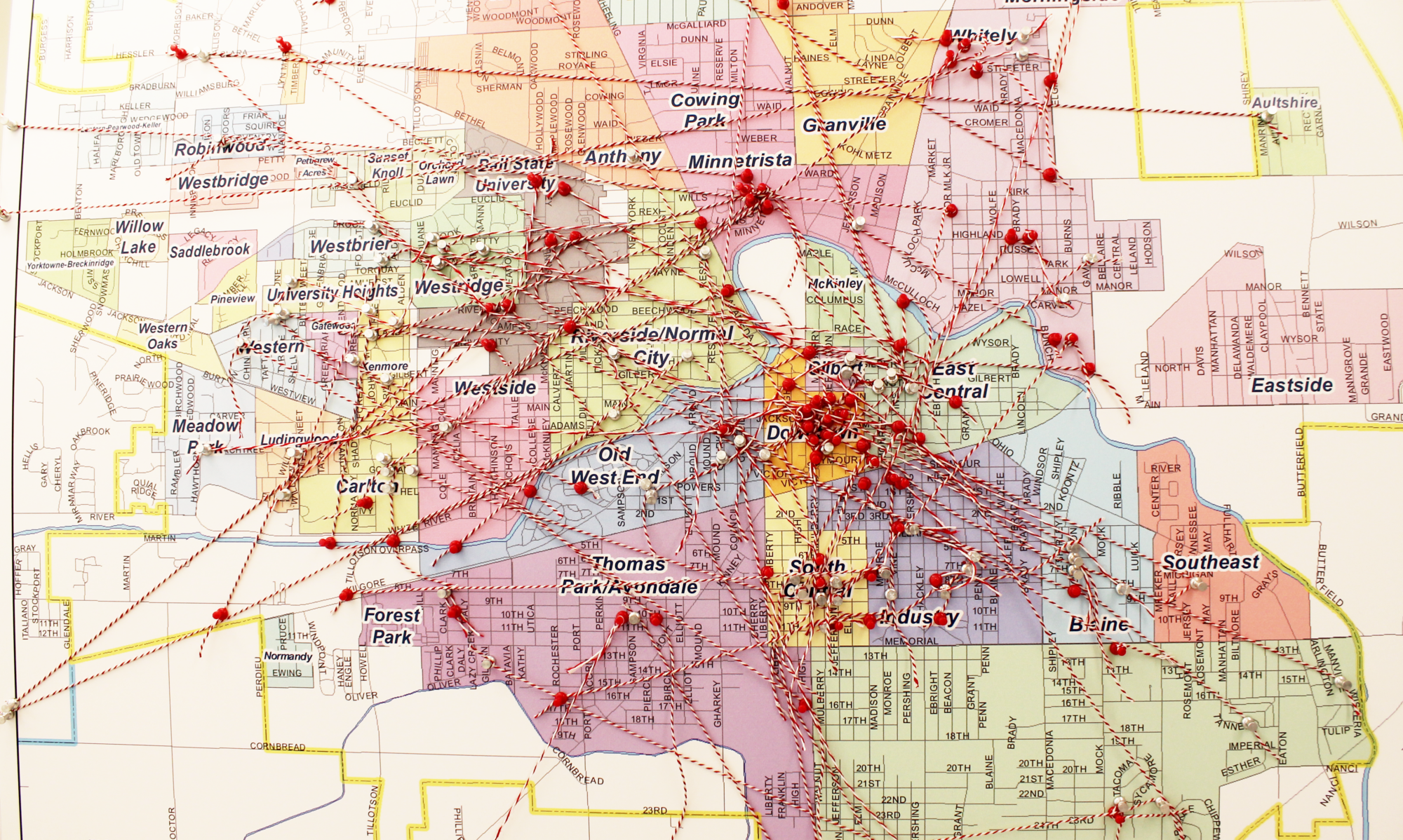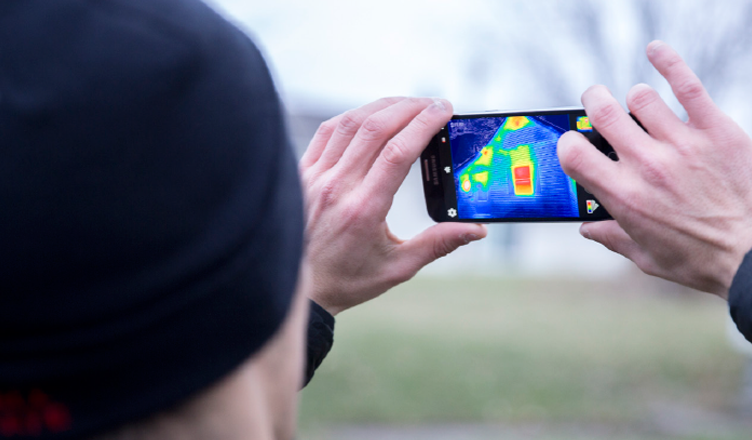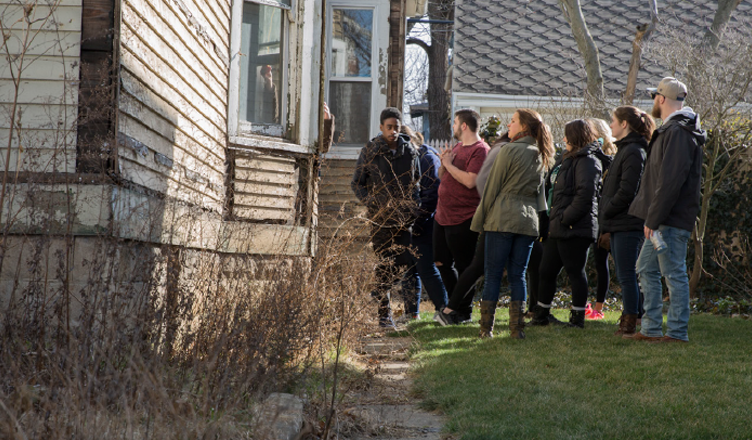Spring 2019: In this immersive learning course, an interdisciplinary team of students worked on rehabilitating existing houses for local nonprofit organizations. The class involved the design and pre-construction phases. Each project started with creating measured existing drawings, determining the scope of work needed, making recommendations for revisions, and then creating plans for the remodeling of the houses. They worked with representatives from the non-profit organizations throughout the process, to ensure the designs meet the needs of the clients. This project began in Fall of 2012, and over the course of eleven semesters, has produced plans for the renovation (or new construction) of 30 houses. Additionally, this semester, the students completed three sets of plans for rehabilitating houses in the 8Twelve area.
Fall 2018: In this immersive learning course, the interdisciplinary team of students (construction management, architecture and interior design) worked on rehabilitating two existing houses for a local non-profit, Urban Light CDC. The class involved the design and preconstruction phases, before construction began. Each project started with creating measured existing drawings, and then determined the scope of work needed, made recommendations for revisions and created plans for the remodeling of the houses. They worked with representatives from Urban Light throughout the process to ensure their designs meet the needs of their clients.
Fall 2017 and Spring 2018: In this immersive learning course, the interdisciplinary team of students worked on rehabilitating existing houses for Habitat for Humanity. The class involved the design and preconstruction phases before construction began. Each project started with creating measured existing drawings, determining the scope of work needed, making recommendations for revisions, and then creating plans for the remodeling of the houses. They worked with representatives from Habitat throughout the process to ensure their designs meet the needs of their clients.
Spring 2017: An interdisciplinary team of students (construction management and architecture) engaged in redesigning structures for Greater Muncie Habitat for Humanity to prepare the structures for restoration and renovation. The main tangible outcome was the final documents (construction drawings, scope of work, list of materials and budget) which will then be used by Greater Muncie Habitat for Humanity to rehabilitate each house. This semester the documents for two houses will be completed and these houses will then be remodeled in 2017. Students completing this experience received relevant professional experience, as rehabilitating existing structures is a major part of their future professions. The targeted majors, construction management and architecture, will work together throughout their careers, frequently for the same companies. The interdisciplinary student teams in this class were invaluable in providing the students the opportunity to understand the contributions of, and their relationship to, the other professions.
Spring 2019
Faculty Mentor: Janet Fick
Department: Construction Management and Interior Design
Community Partners: Greater Muncie Habitat for Humanity, Muncie Mission, Urban Light LLC
Students: Nicholas Beamish, Joshua Brann, Jenna Effinger, Matthew Johnston, Leonard Kline, Spencer McKenney, Jon Miller, Nicholas Murphy, Adycin Rager, Paynter Rhed, Emily Schripsema, John Spencer, Aaron Strayer
Fall 2018
 Faculty Mentor: Janet Fick
Faculty Mentor: Janet Fick
Department: Construction Management and Interior Design
Community Partner: Urban Light CDC
Students:Joey Bastian, Madison Castleman, Megan Draper, Taylor Hindman, Natalie Hopf, Jordan Jones, Drew Keil, Susan Lamermayer, Katie McCauley, Stephen Rosiek, Kayli Sommers, Austin White
Spring 2018
 Faculty Mentor: Janet Fick
Faculty Mentor: Janet Fick
Department: Construction Management and Interior Design
Community Partner: Greater Muncie Habitat for Humanity
Students: Justin Baker, Schyler Cerqueira, William Hack, Meaghan Heinrich, Kelsie Kittredge, Logan Melton, Erin Powichroski, Colten Showalter, Joseph St. Clair, Vanessa Wigent
Fall 2017
Faculty Mentor: Janet Fick
Department: Construction Management and Interior Design
Community Partner: Greater Muncie Habitat for Humanity
Students: Dennis Basham, Noah Donica, Drew Fairchild, Michael Fleck, Jessica Franke, Stephanie Kailey, Scott Manners, Jacob Mattingly, Collin Mercer, Katie Mercer, Kristine Punzalan, Zachary Rooker, Grant Small
Spring 2017
 Faculty Mentors: Janet Fick
Faculty Mentors: Janet Fick
Departments: Technology
Community Partner: Greater Muncie Habitat for Humanity
Students: Courtney Castleman, Emily Epple, Kaylee Jacoob, Ryan Johnston, Toby McClintic, Collin Mercer, Katie Mercer, Haylee Moscato, Brayton Underhill, Tyler Woolen, Chase Woosley




 Faculty Mentor: Janet Fick
Faculty Mentor: Janet Fick
 Faculty Mentors: Janet Fick
Faculty Mentors: Janet Fick

